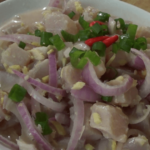I’d like to believe that one secret to having an agreeable marriage is general agreement over food. Jan and I seem to share a common love for good food regardless of place of origin. We remain fiercely loyal to our Filipino food roots, but we relish eating great tasting dishes from a variety of other countries.
One of our long time favorites is Japanese food. We both developed a liking for Japanese food even before we started working for Japanese bosses. Jan and I used to sit at separate tables at work but we both stole glances at the managers’ table not far off with the aromatic rice and nicely plated dishes.
Jan’s recipe is a bit of a leap this week. I’m not quite sure if the Japanese are sensitive over their food traditions. I remember reading once that some Italians don’t appreciate differently executed pasta recipes (I wonder what they think of Filipino sweet spaghetti with ketchup), but I’m not sure if this is the case with some Japanese.
The actual inspiration for this recipe is Jan’s twisted subconscious. Seriously, he came up with it because there aren’t a lot of special ingredients in our supermarket and whenever they are available, their prices are quite prohibitive. The sight of the price of one kilo of Japanese rice can give you a mild stroke if you’re a minimum wage earner.
Ingredients:
About 50-60 grams of blue marlin cut in thin rectangles
1 cup glutinous rice
1 strip pandan leaf (screwpine leaf in English)
1/4 cup thinly sliced onion, salted (optional)
Calamansi/lime
Kikkoman sashimi soy sauce
Procedure:
1. Cook glutinous rice. One cup of rice to one cup of water.
2. Cut the pandan leaf strip into shorter strips and add to the rice just before it is fully cooked, as soon as the water starts to disappear. Remove pandan strips and set aside.
3. On a plate, spoon some of the cooked rice and form into oblong pieces. Top each piece with a slice of fish.
4. Serve with onion side dish (optional), calamansi and sashimi soy sauce. Makes eight pieces. Serves two.
Wife’s Verdict:
This was an absolute surprise. Of course, the texture of the rice was a bit different from Japanese rice but this substitution seemed to have worked great. The light earthy aroma and flavor of pandan was perhaps a unifying factor between the main ingredients.
By the way, I have no idea which pandan species in English can be used to add flavor and aroma to dishes. I can’t say for certain if there are any pandan leaves outside of the Philippines that might be dangerous.
Jan’s Tip: “Want mildly cooked fish? Put calamansi on the fish strip and set it aside. After a few minutes, you’ll find it slightly cooked.”




Wow guys you've really done well with this dish, its great. Great to connect with you both, I've subscribed, so looking forward to more 🙂
Hi Anna. Thanks for subscribing. Stay tuned for more great stuff 🙂